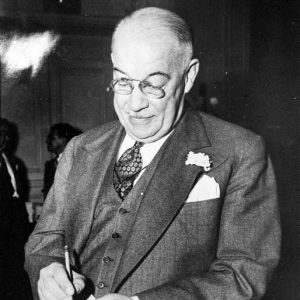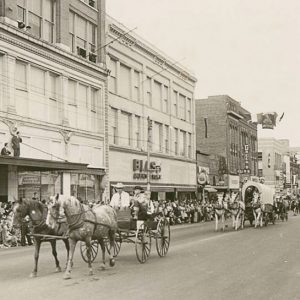calsfoundation@cals.org
Arkansas Livestock Show Association
The Arkansas Livestock Show Association (ASLA) is the umbrella organization that owns much of the Arkansas State Fair Complex, produces the annual Arkansas State Fair and Livestock Show, and oversees numerous events and activities year round at the fairgrounds on Roosevelt Road in Little Rock (Pulaski County).
The Arkansas Livestock Show Association has its roots in the Great Depression and its aftermath. By the mid-1930s, Arkansas was still feeling the effects of the Depression, and its economy was in shambles. The state’s only money crop—cotton—was in decline, and farmers were in trouble.
In 1937, the University of Arkansas Cooperative Extension Service (UACES) conducted a study of the state’s resources and concluded that raising livestock would be profitable in the state. A number of Arkansas educators, businessmen, and agricultural leaders decided that holding a livestock exposition would help educate farmers that raising livestock would be a sound and profitable venture. Prominent among those leaders was M. W. Muldrow, an Extension Service livestock specialist, who spearheaded the movement to hold a state livestock show. These leaders formed the Arkansas Livestock Exposition (now the Arkansas State Fair and Livestock Show) with a board of directors that included prominent Arkansans throughout the state. They selected oil businessman Colonel Thomas Harry Barton of El Dorado (Union County) to head the new organization. This group formed the Arkansas Livestock Show Association and incorporated it on February 12, 1938.
The new organization chose as its objectives: 1) to increase the income of farmers, 2) to provide year-round work for farmers and their workers, 3) to reduce uneconomic importation of food, 4) to improve volume and quality of livestock, dairy products, and poultry production, 5) to reduce dependence on cotton as the main cash crop, 6) to rebuild the fertility of the soil, 7) to check soil erosion, 8) to enable profits on non-profitable land, and 9) to increase the general physical wealth of the state.
The first Arkansas Livestock Show was held November 9–13, 1938, in conjunction with the Arkansas State Fair. The show was held in North Little Rock (Pulaski County) for five years on land given by the city, but after a massive fire destroyed all its buildings shortly after 1942’s fair, the U.S. Army Corps of Engineers seized the land for its World War II efforts. The show and fair were moved to Pine Bluff (Jefferson County) in 1943. No show or fair were held in 1944 and 1945 because of demands and shortages related to World War II. In 1945, Little Rock offered land on Roosevelt Road, the site of the current show.
The most prominent building constructed at this site was the T. H. Barton Coliseum, named after the long-time president of the association, T. H. Barton. Construction on Barton Coliseum began in 1948, amid the prosperity that followed World War II, and the building was dedicated on September 29, 1952. Barton has more than 7,000 seats, although for some occasions, the arena can accommodate slightly over 10,000 at maximum capacity. The building has been widely used for concerts and a rodeo at the Arkansas State Fair but is also used year-round for concerts, trade shows, conventions, arts and crafts shows, and special events.
Most of the buildings on the fairgrounds are directly related to and used at the Arkansas State Fair, but efforts are made year-round to rent these for other purposes, from meetings, concerts, and conventions to family reunions, special events, and revivals. The current Arkansas State Fairgrounds Complex consists of many permanent buildings. The biggest ones—in addition to Barton Coliseum—include the Hall of Industry, the Arts and Crafts Building, the Arkansas Building, and the Farm and Ranch Building.
The grounds also include an Equestrian Center, which is a covered outdoor arena with seating for up to 1,000; permanent restaurant buildings run by the poultry and pork associations; an association-controlled restaurant building; and an administration building, where offices of the ALSA are located. That building also has a conference room where association board meetings are held.
The State of Arkansas owns the main fairgrounds property, and the ALSA has a fifty-year lease on it, renewed in 2006. The association owns some of the buildings, and the city and state own others. ALSA receives some state funding, but that amounts to only about twenty-five percent of its current total annual budget. The association has around twenty full-time employees and hires at least 500 temporary workers during the annual state fair.
The fundamental mission of the Arkansas Livestock Show Association is to generate funds to give premiums to young farmers and ranchers in the annual junior livestock shows. Sponsorships throughout the fairgrounds (buildings, shows, events, and special nights) help bolster association income.
In addition to the fall and spring junior livestock shows, the association sponsors the Purple Circle Club, whose members are the exhibitors of the grand champions in the Junior Livestock Show. It also actively supports the 4-H Clubs, which began in Arkansas in 1908, and the Future Farmers of America, which began in Arkansas in 1928.
For additional information:
Arkansas State Fair. http://www.arkansasstatefair.com (accessed November 17, 2025).
Dean, Jerry. “50 Years at the Fair.” Arkansas Gazette, October 7, 1989, p. 1E.
C. Dennis Schick
North Little Rock, Arkansas


 Arkansas State Fair Grounds
Arkansas State Fair Grounds  T. H. Barton
T. H. Barton  Livestock Show Parade
Livestock Show Parade 



Comments
No comments on this entry yet.